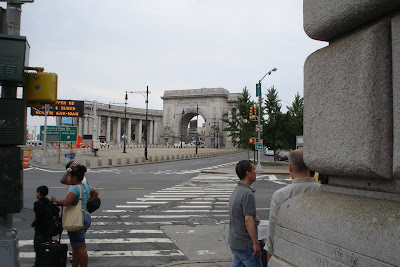Since we're good walkers and New York is a walking city, we decided to visit the historical sites of northern Manhattan today, starting at 204th Street around the corner, and working our way downtown from Duyckman's Farm, the house built up here in 1784.
The Hessians were camped on the Duyckmans' property in 1776 and the original farmhouse closer to the Harlem River, northeast of here, was destroyed during the Revolutionary War, which is why Duyckman decided to rebuild his farmhouse here instead, at the corner of 204th and Broadway (as it is now), after he returned from upstate (where he'd kept his head down during hostilities).
The Hessians' huts were dug into slopes around here and I didn't realise that when they were doing archeological work up here in 1915 Pelham Bolton found remnants of their huts in the hill on Payson Ave, visible outside the window where I've been working.
I also noticed, from a period map reproduced on a plaque in the grounds that Spuyten Duyvil, the waterway up near the conjunction of the Harlem River and Hudson, was once translated as Spitting Devil, rather than 'in spite of the devil', but I guess this still denotes a dangerous stretch of water.
From Duyckman's we walked to 160th Street, traversing the street-level cityscape we've been missing each time we've caught the 'A', and arrived at the Morris-Jumel Mansion at 160th Street. Washington used this house as his headquarters in 1776.
On 10 July, 1790, in the first year of his presidency, he invited his cabinet up here for a day trip from the capitol downtown. I can imagine Washington, Vice President Adams, Secretary of State Jefferson, Treasury Secretary Hamilton and Adams' son, John Quincy, coming through this foyer reminiscing about the days when the outcome of the struggle was far from certain and whether they would all escape with their lives.
Hamilton wouldn't have known that the house would one day, in 1833, become the home of a former vice president Aaron Burr, the man who would take his life in a duel in1804.
Did the party look out this window?
Washington would surely have. His office during the war was back of here, in an octagonal room (if not quite an oval office).
Around the corner, at 16 Jumel Place, is a fine old Victorian building which was once the home of Paul Robeson.
We weathered the heat (how did people cope in 1790? I was in shorts) to walk on down to 141st Street where Hamilton's 'country retreat' is now located.

Here is the home of one of America's founding geniuses. I admire Hamilton not just because he found a financial underpinning for the infant republic in the 1790s, but because he espoused the idea of 'implied powers'. He believed as did the whole revolutionary generation that governments are instituted among men to ensure their welfare. Hamilton argued that the consitution gave the government certain powers to achieve that end and that government had the right to do whatever is necessary to achieve the ends specified to it. In 1790, he and Jefferson were yet to become as bitterly opposed as they would eventually become. Jefferson believed in a more literal reading of the constitution: government cannot assume any power not specifically delegated to it. I love Jefferson's idea that everyone should have a farm, but I'm glad that in arguments before Washington, Hamilton usually won out. In the early 1800s, after Hamilton was dead, Adams and Jefferson also fell out over similar positions, but in the last years of their lives, resumed their friendship. (A lesson for today's opponents? Even Burr on his deathbed is supposed to have said, 'I've realised, all too late, that there is room in the world for an Alexander Hamilton and an Aaron Burr.')
This is the house's third move since the 1890s, but it is now only two blocks from its original location at W143rd, and on land which was once Hamilton's estate. This is now St. Nicholas' Park, and when you come out of it, you're in sugar Hill, where Duke Ellington once lived. Downtown is still some way away, and you can see the Empire State Building in the distance.
We were tempted to walk on to the Gershwin House at 103rd - not really, we were beat. The temperature was in the 90s. So we went only as far as 125th Street. It's Harlem, but I thought I was hallucinating when I looked across the road and saw this building.
We'd been trying to evoke a sense of New York 200 years ago, and we see this. Ignore the Jimmy Jazz sign, this building wouldn't look out of place in Prahran - Chapel Street!!!















